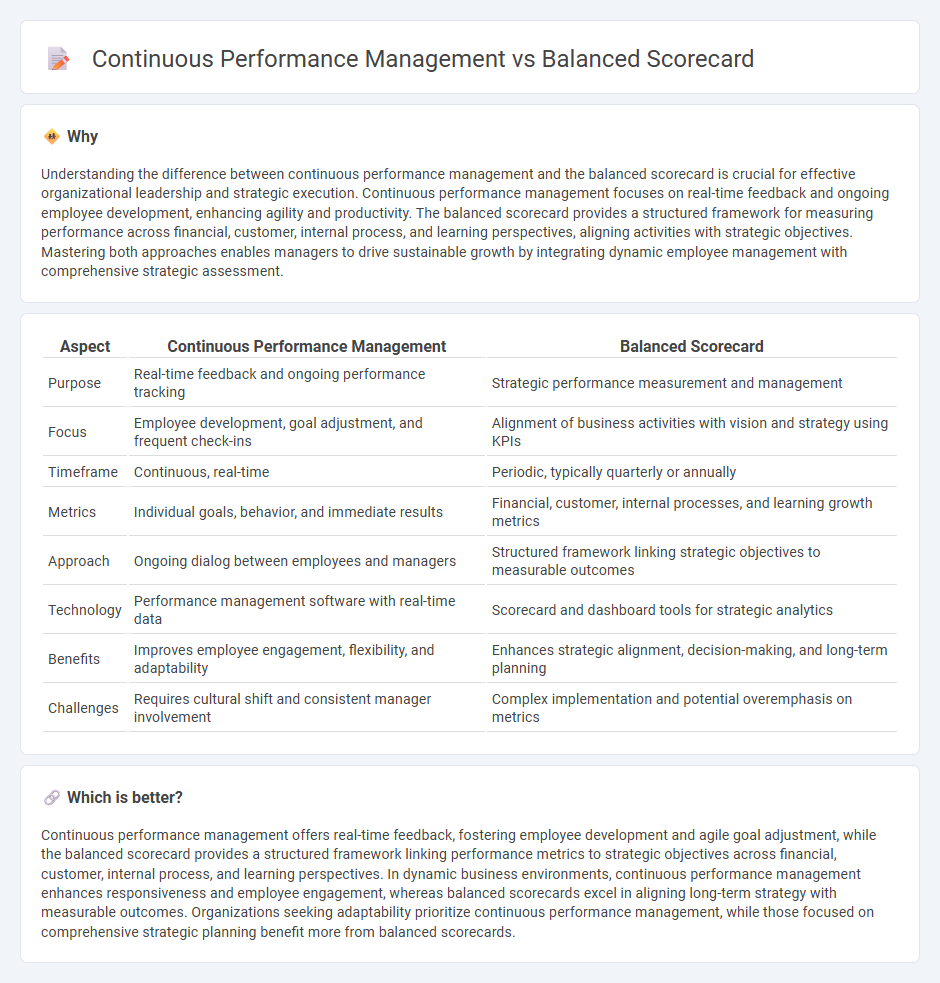
Continuous performance management emphasizes real-time feedback, frequent goal adjustments, and ongoing employee development to drive productivity and engagement. Balanced Scorecard integrates financial and non-financial metrics across four perspectives--financial, customer, internal processes, and learning and growth--to align strategic objectives with performance measurement. Explore how combining these approaches can transform organizational effectiveness and strategic execution.
Why it is important
Understanding the difference between continuous performance management and the balanced scorecard is crucial for effective organizational leadership and strategic execution. Continuous performance management focuses on real-time feedback and ongoing employee development, enhancing agility and productivity. The balanced scorecard provides a structured framework for measuring performance across financial, customer, internal process, and learning perspectives, aligning activities with strategic objectives. Mastering both approaches enables managers to drive sustainable growth by integrating dynamic employee management with comprehensive strategic assessment.
Comparison Table
| Aspect | Continuous Performance Management | Balanced Scorecard |
|---|---|---|
| Purpose | Real-time feedback and ongoing performance tracking | Strategic performance measurement and management |
| Focus | Employee development, goal adjustment, and frequent check-ins | Alignment of business activities with vision and strategy using KPIs |
| Timeframe | Continuous, real-time | Periodic, typically quarterly or annually |
| Metrics | Individual goals, behavior, and immediate results | Financial, customer, internal processes, and learning growth metrics |
| Approach | Ongoing dialog between employees and managers | Structured framework linking strategic objectives to measurable outcomes |
| Technology | Performance management software with real-time data | Scorecard and dashboard tools for strategic analytics |
| Benefits | Improves employee engagement, flexibility, and adaptability | Enhances strategic alignment, decision-making, and long-term planning |
| Challenges | Requires cultural shift and consistent manager involvement | Complex implementation and potential overemphasis on metrics |
Which is better?
Continuous performance management offers real-time feedback, fostering employee development and agile goal adjustment, while the balanced scorecard provides a structured framework linking performance metrics to strategic objectives across financial, customer, internal process, and learning perspectives. In dynamic business environments, continuous performance management enhances responsiveness and employee engagement, whereas balanced scorecards excel in aligning long-term strategy with measurable outcomes. Organizations seeking adaptability prioritize continuous performance management, while those focused on comprehensive strategic planning benefit more from balanced scorecards.
Connection
Continuous performance management enhances strategic alignment by providing real-time feedback and ongoing goal adjustments that directly support the balanced scorecard's four perspectives: financial, customer, internal processes, and learning and growth. Integrating continuous performance management with the balanced scorecard drives improved organizational performance through consistent tracking of key performance indicators (KPIs) aligned with strategic objectives. This connection ensures agility in execution while maintaining a holistic view of business success metrics.
Key Terms
Key Performance Indicators (KPIs)
Balanced Scorecard integrates financial and non-financial KPIs across four perspectives: financial, customer, internal processes, and learning and growth, providing a comprehensive view of organizational performance. Continuous Performance Management centers on real-time KPI tracking and frequent feedback to enhance individual and team productivity through ongoing evaluation. Explore deeper insights into aligning KPIs for strategic success and operational agility.
Strategy Alignment
Balanced scorecard emphasizes structured strategy alignment through defined perspectives and measurable objectives, ensuring organizational goals translate into actionable performance metrics. Continuous performance management fosters dynamic strategy alignment by facilitating real-time feedback, goal adjustments, and ongoing employee development to adapt swiftly to changing priorities. Explore how these approaches optimize strategic execution and drive organizational success.
Real-time Feedback
Balanced scorecard traditionally emphasizes strategic objectives across financial, customer, internal processes, and learning perspectives, often reviewed quarterly or annually, limiting real-time feedback opportunities. Continuous performance management centers on ongoing, real-time feedback and frequent check-ins to align employee performance with dynamic goals and immediate improvements. Discover how integrating real-time feedback can transform organizational performance by exploring these approaches further.
Source and External Links
Balanced Scorecard - Management Tools - A Balanced Scorecard measures an organization's performance by translating purpose and vision into objectives and performance measures across various categories like financial, customer, and internal processes.
What Is a Balanced Scorecard? - The balanced scorecard is a tool developed by Robert Kaplan and David Norton to track and measure non-financial variables, typically focusing on four perspectives: financial, customer, process, and learning and growth.
Balanced Scorecard Basics - The balanced scorecard is a strategic planning and management system that aligns daily work with strategy, prioritizes projects, and measures progress towards strategic targets.
 dowidth.com
dowidth.com